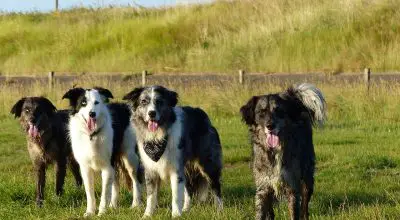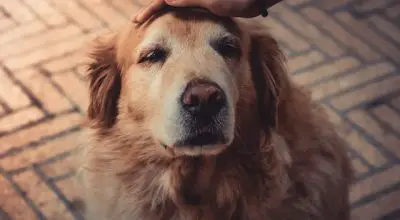Some dog breeds are generally healthy dog breeds. It includes the Border Collie. However, there are instances when they are not exempted from acquiring some particular canine diseases or disorders. One of these is the so-called dog’s OCD or osteochondritis dissecans. What is it and how it can affect your dog?
What Is Osteochondritis Dissecans in Dogs?
OCD in dogs, also recognized as osteochondritis dissecans, is a neurocognitive orthopedic disorder. The bone tissue keeps on failing to ossify or transform into a joint resulting in the development of a dense area of remnant tissue that is vulnerable to injury and necrosis. This process can expose subchondral bone, which is highly innervated and causes pain in the dog when exposed to joint fluid.
Among other joints in the body, OCD can affect the arm, shoulder, lower limbs, and stifle. The most common location for OCD in dogs is the neck joint, accompanied by the tarsus, forearm, and squelch. Various joints within the same dog may be affected in some cases.
Even though shoulder OCD has already been reported to take place bilaterally in up to 68 percent of dogs, roughly 30 percent of cases are two-way or those that occur on both sides.
There seem to be two types of OCD that really can appear in dogs. In one type, a skeletal deficiency may shape close the tendon, causing issues with the way the joint functions. Another possibility is that a cartilage or bone fragment will form, resulting in an unequal, incompatible joint. The probability of a cartilage fragment detaching and floating freely within the joint is referred to by veterinarians as “joint mice.”
Are Some Dog Breeds More Likely To Get OCD?

OCD in dogs mainly affects young huge breeds of dogs, with small dogs being the exception. A neurodevelopment disorder that affects quickly developing huge breeds of dogs between the ages of six as well as 9 months, OCD is more common in male dogs. This disease, however, is more common in dogs who consume an excessive amount of energy and calcium.
How To Know If My Dog Will Develop OCD?
Just like any other diseases affecting canines, osteochondritis dissecans in dogs is noticeable through the following doggy behavior:
- Chewing on their right flank or a train set
- Constant licking, known as inflamed lick skin problems
- Repetitive movements, rotating and trying to chase the tail
- Chilling and gazing
- Popping at mosquitoes or intangible objects
- Unceasing and styled barking
- Heavy drinking of water or ingesting dirt
What Causes OCD In Dogs?
Nobody knows what causes OCD, though a variety of factors may be involved. Most dogs, particularly Newfoundlands, are thought to have a hereditary component. Before purchasing a puppy, specifically, ask your breeder if the dog’s mom and dad possess OCD. In general, it is considered multi-factorial, meaning that it is caused by a combination of factors.
Diet, in addition to genetics, plays a role; specifically, for pups whose meal contains an excess of nutrients or vitamins, dosing must be avoided. Furthermore, any attempt to get the dog to develop as big as possible should be avoided. It is best to allow the dog to grow to the size that nature intended without dietary intervention.
What Are Symptoms & Signs of Osteochondritis Dissecans in Dogs?
In the case of osteochondrosis, one of the symptoms is osteochondritis dissecans (OCD). The abnormalities in cartilaginous growth and endodermal calcifications are thought to be at the root of this disorder. So, we call any problem with growing cartilage differentiation osteochondrosis. Every time this condition has an adverse effect on joint cartilage and causes a fragment to separate, we call that articular detachment.
Lameness or a limp is a common symptom of OCD in dogs. There will be, at some point, an application of pressure to the injured joint or manipulation of the injured joint during an orthopedic assessment. In such cases, the dog regularly cries out in pain. Swollen and hot to the touch, the damaged joints are a telltale sign. Some dogs might experience slight or sporadic lameness. But, other dogs suffer from constant pain and try not to use the affected limb.
How To Diagnose Osteochondritis Dissecans in Dogs?

The condition known as osteochondritis dissecans is so well known but poorly understood. The etiology is still debatable. Osteochondritis dissecans is most popularly seen in the arm, but it can also occur in other areas, making it difficult to distinguish it from other disease entities. OCD is diagnosed through signalment (age, breed, and sex), history, and physical and radiological evidence.
A veterinarian’s diagnosis and intervention are critical as soon as possible. Compulsive behaviors can be harmful to your dog, your home, and your relationships, and they are often difficult to live with. Treatment must be tailored to the patient’s clinical symptoms rather than the severity of the radiographic lesion. And if they are not treated, they will only worsen.
How To Treat OCD in Dogs?
One of the most difficult issues we face when dogs exhibit OCD behaviors is that they can’t tell us what they’re obsessed with. As a result, it can be difficult to diagnose. Is your dog just hyperactive, or is there something else going on? It’s not so much what they do as it is how they do it. So, it is better to see your veterinarian because some behaviors may be caused by an underlying medical condition.
When you visit the vet, it will assist if you have a great description of what is happening – video recordings are great. A record of how and when often the behavior patterns happen is also of big help. Moreover, the vet may also assist with whether any specific scenario would seem to set them off, and also how old the dog was when the behavior patterns began.
Treatment and behavior pattern modification have been effective remedies for some dogs.
Because dogs with OCD have a modified serotonin level, treatments that impact serotonin absorption can help to reduce some behaviors. This must be merged with the instruction of new behaviors that disturb and divert compulsive behaviors, such as sitting rather than rotating when excited.
Post-OCD Surgery Aftercare of Your Dog
There are a number of benefits to performing an arthroscopy instead of open surgery on a joint. One of its features is the capability of simultaneously treating both sides. The coverage period also includes a shorter two-week recuperation time than the four-to-six-week time frame required after an arthrotomy procedure.
Because of the need for the incision to heal and the repaired aberrant tissue to stabilize, postoperative activity restrictions are necessary. When arthrotomy, an open surgical method, is performed on a dog, especially one that is extremely active, it is not uncommon for the dog to develop a seroma, also known as a liquid obstruction structure. Physiotherapy and exercises that don’t put pressure on the injured area, like swimming, are recommended.
What Is the Prognosis of a Dog With Osteochondritis Dissecans?
The prognosis for OCD in pups following surgery is generally favorable. Most dogs improve and are walking normally within 4-6 weeks of receiving treatment. Some dogs, however, may experience infrequent lameness or distress and will need to implement and review with medication and/or combined nutrition. This is particularly true if the peroneal tendon or the thigh joints are impacted.
How To Prevent OCD In Dogs?
Many factors can contribute to osteochondrosis and OCD, such as genetic factors, fast development, an enormous amount of calcium intake, and trauma. Genetic management is one method of preventing OCD. In other words, impacted dogs should be neutered or spayed to stop passing on the genetic characteristics that may occur in this situation to the coming generations.
Furthermore, owners should be conscious that a delayed rate of growth may decrease the likelihood of OCD. Many vets suggest lesser diets for large-breed, evolving dogs for this reason. Vitamins should be avoided. Several vets may also suggest food supplements such as glucosamine that aim to help the joint sustain normal cartilage and avoid the onset of joint pain.
Because tough cement or lumber walking floors can cause trauma, puppies of vulnerable breeds should walk on softer surfaces, such as rugs.
Border Collies And OCD

Joint inflammation is the end outcome of osteochondritis dissecans, a condition of the skeleton. The shoulder is the most prevalent location for Border Collies to experience this disorder. Too rapid canine development is a common cause of this condition, which highlights the significance of feeding a well-balanced diet with the right amount of each mineral and protein.
To reduce the chance of this illness, puppies shouldn’t be exercised on hard surfaces, jumped out of automobiles or off furniture, or climbed stairs before their joints have fully formed. Although older dogs can be affected, the majority of those that display symptoms like lameness and pain do so before their first birthday. The prognosis for a dog with Osteochondritis Dissecans who has undergone treatment is good, however, relapse is uncommon.


